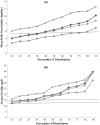Iron intakes and status of 2-year-old children in the Cork BASELINE Birth Cohort Study
- PMID: 27501864
- PMCID: PMC6865992
- DOI: 10.1111/mcn.12320
Iron intakes and status of 2-year-old children in the Cork BASELINE Birth Cohort Study
Abstract
Young children are at risk of iron deficiency and subsequent anaemia, resulting in long-term consequences for cognitive, motor and behavioural development. This study aimed to describe the iron intakes, status and determinants of status in 2-year-old children. Data were collected prospectively in the mother-child Cork BASELINE Birth Cohort Study from 15 weeks' gestation throughout early childhood. At the 24-month assessment, serum ferritin, haemoglobin and mean corpuscular volume were measured, and food/nutrient intake data were collected using a 2-day weighed food diary. Iron status was assessed in 729 children (median [IQR] age: 2.1 [2.1, 2.2] years) and 468 completed a food diary. From the food diary, mean (SD) iron intakes were 6.8 (2.6) mg/day and 30% had intakes < UK Estimated Average Requirement (5.3 mg/day). Using WHO definitions, iron deficiency was observed in 4.6% (n = 31) and iron deficiency anaemia in five children (1.0%). Following an iron series workup, five more children were diagnosed with iron deficiency anaemia. Twenty-one per cent had ferritin concentrations <15 µg/L. Inadequate iron intakes (OR [95% CI]: 1.94 [1.09, 3.48]) and unmodified cows' milk intakes ≥ 400 mL/day (1.95 [1.07, 3.56]) increased the risk of low iron status. Iron-fortified formula consumption was associated with decreased risk (0.21 [0.11, 0.41] P < 0.05). In this, the largest study in toddlers in Europe, a lower prevalence of low iron status was observed than in previous reports. Compliance with dietary recommendations to limit cows' milk intakes in young children and consumption of iron-fortified products appears to have contributed to improved iron status at two years.
Keywords: anaemia; birth cohort; cows' milk consumption; food fortification; iron deficiency; iron intakes.
© 2016 John Wiley & Sons Ltd.
Conflict of interest statement
The authors declare that they have no conflict of interest.
Figures

Similar articles
-
Dietary strategies for achieving adequate vitamin D and iron intakes in young children in Ireland.J Hum Nutr Diet. 2017 Aug;30(4):405-416. doi: 10.1111/jhn.12449. Epub 2016 Dec 18. J Hum Nutr Diet. 2017. PMID: 27990698
-
Dietary intakes of 6-24-month-old urban South Island New Zealand children in relation to biochemical iron status.Public Health Nutr. 2002 Apr;5(2):339-46. doi: 10.1079/PHN2002257. Public Health Nutr. 2002. PMID: 12020386
-
Iron status in 2-year-old Icelandic children and associations with dietary intake and growth.Eur J Clin Nutr. 2004 Jun;58(6):901-6. doi: 10.1038/sj.ejcn.1601910. Eur J Clin Nutr. 2004. PMID: 15164111
-
Iron requirements of infants and toddlers.J Pediatr Gastroenterol Nutr. 2014 Jan;58(1):119-29. doi: 10.1097/MPG.0000000000000206. J Pediatr Gastroenterol Nutr. 2014. PMID: 24135983 Review.
-
Home fortification of foods with multiple micronutrient powders for health and nutrition in children under two years of age (Review).Evid Based Child Health. 2013 Jan;8(1):112-201. doi: 10.1002/ebch.1895. Evid Based Child Health. 2013. PMID: 23878126 Review.
Cited by
-
Factors influencing childhood anaemia in Bangladesh: a two level logistic regression analysis.BMC Pediatr. 2019 Jun 29;19(1):213. doi: 10.1186/s12887-019-1581-9. BMC Pediatr. 2019. PMID: 31255172 Free PMC article.
-
High-risk fertility behaviour and childhood anaemia in sub-Saharan Africa.BMJ Open. 2022 May 11;12(5):e051921. doi: 10.1136/bmjopen-2021-051921. BMJ Open. 2022. PMID: 35545380 Free PMC article.
-
In vitro assessment of iron availability from commercial Young Child Formulae supplemented with prebiotics.Eur J Nutr. 2018 Mar;57(2):669-678. doi: 10.1007/s00394-016-1353-3. Epub 2016 Dec 9. Eur J Nutr. 2018. PMID: 27942845 Free PMC article.
-
Barriers to Healthy Eating and Influences on the Dietary Patterns and Eating Behaviours of 18-36-Month-Old Children in Ireland.J Hum Nutr Diet. 2025 Jun;38(3):e70084. doi: 10.1111/jhn.70084. J Hum Nutr Diet. 2025. PMID: 40563218 Free PMC article.
-
Very low prevalence of iron deficiency among young French children: A national cross-sectional hospital-based survey.Matern Child Nutr. 2018 Jan;14(1):e12460. doi: 10.1111/mcn.12460. Epub 2017 May 3. Matern Child Nutr. 2018. PMID: 28466606 Free PMC article.
References
-
- Bates B., Lennox A., Prentice A., Bates C., Page P., Nicholson S. et al (2014) National Diet and Nutrition Survey Results from Years 1, 2, 3 and 4 (combined) of the Rolling Programme (2008/2009 – 2011/2012), The Department of Health and Food Standards Agency.
-
- Black L.J., Ireland J., Møller A., Roe M., Walton J., Flynn A. et al. (2011) Development of an on‐line Irish food composition database for nutrients. Journal of Food Composition and Analysis 24 (7), 1017–1023.
-
- Brotanek J.M., Gosz J., Weitzman M. & Flores G. (2007) Iron deficiency in early childhood in the United States: risk factors and racial/ethnic disparities. Pediatrics 120 (3), 568–575. - PubMed
-
- Capozzi L., Russo R., Bertocco F., Ferrara D. & Ferrara M. (2010) Diet and iron deficiency in the first year of life: a retrospective study. Hematology 15 (6), 410–413. - PubMed
MeSH terms
Substances
LinkOut - more resources
Full Text Sources
Other Literature Sources
Medical

